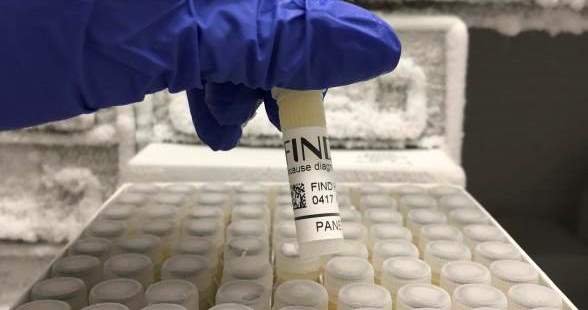Tuberculosis

In 2019, 7.1 million people were newly diagnosed with TB, with millions more going undetected and untreated. Supporting the global aim to ‘end tuberculosis’, the FIND Specimen Bank holds over 280,000 patient samples from endemic countries in Africa, Latin America, and South-East Asia. From point-of-care diagnostics to ‘test of cure and treatment’ monitoring, FIND has the varieties and volumes of samples needed to move products through every stage of development. Available to academic, non-profit, independent and commercial researchers, we can limit the number of immature product trials, streamline the development of diagnostic tools, and support the goal of preventing, controlling and managing TB.
Our collection
Covering all strains of the disease (including multidrug-resistant and pre-XDR patients) sample types include, sputum, serum, urine, whole blood, and PAXgene, amongst others. Collections take place at qualified clinics under a protocol approved by an Institutional Review Board and with informed consent from patients.
A full list of sample types, characterization and classifications is provided below.
Sample types and categories available*
| Specimen type | Characterization | Volume | Origin |
| Sputum | Smear+/– Culture+/– | 0.5 mL | Africa, Latin America, Southeast Asia |
| Serum | Smear+/– Culture+/– | 0.5 mL | |
| Plasma EDTA | Smear+/– Culture+/– | 0.5 mL | |
| Plasma P800 | Smear+/– Culture+/– | 0.5 mL | |
| Plasma (Streck) | Smear+/– Culture+/– | 0.5 mL | |
| Urine | Smear+/– Culture+/– | 3.5 mL | |
| Urine (Streck) | Smear+/– Culture+/– | 3.5 mL | |
| Saliva | Smear+/– Culture+/– | 0.5 mL | |
| PAXgene tubes | Smear+/– Culture+/– | 2.5 mL | |
| Culture isolates | MDR/XDR (Smear+Culture+specimens) | 1.0 mL |
Complete microbiological and clinical data are collected during enrolment and follow-up and are linked to biological specimens. Associated clinical and characterization data sets are also available upon request.
Classification of specimen categories
Classifications according to clinical and laboratory data include:
- S+C+: Any ZN or FM positive smear, any culture positive and MTB-complex (at enrolment).
- S–C+: All smear negative, any culture positive and MTB-complex (at enrolment).
- Clinical TB CXR+: Smear and culture negative participants treated on clinical grounds (chest X-ray).
- Likely subclinical TB: Smear and culture negative at baseline, culture positive at follow-up.
- Non-TB: Smear and culture negative not treated at enrolment, or completely recovered/improved.
- Non-Latent TB: As for non-TB but also includes available, negative Quantiferon test results.
- Latent TB: As for non-TB but also includes available, positive Quantiferon test results.
*FIND also hosts a TB collection for the Special Programme for Research and Training in Tropical Diseases.
More than a sample supplier
Not sure what type and how many samples you need? While the nature of each request for these and other diagnostic platforms will vary, as a guide we recommend:
- Feasibility: 20−30 well-characterized samples (several aliquots from the same participants)
- Proof of concept: A diversity of 50−100 well-characterized samples representative of patient cohorts
- Clinical validation: A range of 300−400 well-characterized samples
Target product profiles also offer important guidance on the minimum and optimal performance/operational characteristics of priority diagnostic tests for TB. For more information about this, the product development process, or for assistance identifying the number and type of samples needed, please contact our team at specimenbank@finddx.org.
Quick links

